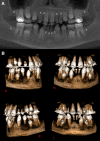The Quebec Dental Anomalies Registry: Identifying genes for rare disorders
- PMID: 37361548
- PMCID: PMC10290489
- DOI: 10.1093/pnasnexus/pgad196
The Quebec Dental Anomalies Registry: Identifying genes for rare disorders
Abstract
There are more than 900 genetic syndromes associated with oral manifestations. These syndromes can have serious health implications, and left undiagnosed, can hamper treatment and prognosis later in life. About 6.67% of the population will develop a rare disease during their lifetime, some of which are difficult to diagnose. The establishment of a data and tissue bank of rare diseases with oral manifestations in Quebec will help medical professionals identify the genes involved, will improve knowledge on the rare genetic diseases, and will also lead to improved patient management. It will also allow samples and information sharing with other clinicians and investigators. As an example of a condition requiring additional research, dental ankylosis is a condition in which the tooth's cementum fuses to the surrounding alveolar bone. This can be secondary to traumatic injury but is often idiopathic, and the genes involved in the idiopathic cases, if any, are poorly known. To date, patients with both identified and unidentified genetic etiology for their dental anomalies were recruited through dental and genetics clinics for the study. They underwent sequencing of selected genes or exome sequencing depending on the manifestation. We recruited 37 patients and we identified pathogenic or likely pathogenic variants in WNT10A, EDAR, AMBN, PLOD1, TSPEAR, PRKAR1A, FAM83H, PRKACB, DLX3, DSPP, BMP2, TGDS. Our project led to the establishment of the Quebec Dental Anomalies Registry, which will help researchers, medical and dental practitioners alike understand the genetics of dental anomalies and facilitate research collaborations into improved standards of care for patients with rare dental anomalies and any accompanying genetic diseases.
Keywords: craniofacial anomalies; genetics; oligodontia; pediatric dentistry.
© The Author(s) 2023. Published by Oxford University Press on behalf of National Academy of Sciences.
Figures


References
-
- Søvik JB, Vieira AR, Tveit AB, Mulic A. 2015. Enamel formation genes associated with dental erosive wear. Caries Res. 49(3):236–242. - PubMed
-
- Andersson L, Blomlöf L, Lindskog S, Feiglin B, Hammarström L. 1984. Tooth ankylosis. Clinical, radiographic and histological assessments. Int J Oral Surg. 13(5):423–431. - PubMed
LinkOut - more resources
Full Text Sources
Research Materials
Miscellaneous

